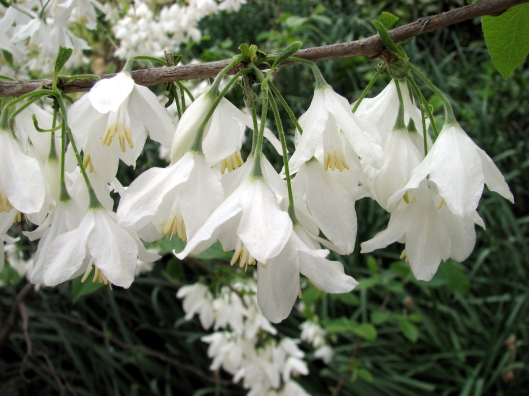This native silverbell deserves its day in the sun. I’ve been admiring it for over thirty years here at SFA Gardens and in landscapes across the South. Showy white 1” bell-faced blooms in May on ¾-inch pedicels are a key feature. While many believe this is part of the shady under forest of the Pineywoods, this tree is really at its best in sun. The more sun, the more flowers. The foliage is attractive, bright green, with alternate leaves and we admit there’s no Fall color to write about. The tree needs watering when young but a well established tree is quite drought tolerant. It’s a native. It reaches 15′ to 30′ at maturity and has an appealing form, often wider than tall. The tree can be used as part of the mixed border, as a specimen small tree as a standard or multi-trunk, along stream edges, in woodland massing, and as part of wildlife habitat.

Halesia diptera var. magniflora in good sun
Our specimens in the shade garden and here and there in the garden come from Newton county,. Texas, originally, and have developed into robust small trees. The bloom is the key feature but the bark interest and tree structure would have to be close behind. The bark is smooth and striated. I can remember a visit by Don Shadow and others last fall and his favorable impression of a small colony of four or five trees in heavy seed. The trees have been trained to single trunks and are very vigorous and flower profusely even though they only receive three to four hours of sun. The tree enjoys a refined grace.

Halesia diptera var. magniflora
Native across the South, there is one form being promoted that has yet to make as big a splash as I thought it would. Halesia diptera var. magniflora is a Florida ecotype with significantly larger blooms. The two-winged Silverbell is often referred to as the American silverbell, which it really is not. That title should go to Styrax americanus, which is more diminutive, more bush like and thicket forming. Two wing silverbell is a tree. Like the American snowbell, think about putting a bench under one, positioned to catch an early morning patch of sun. The silverbell needs a well-drained soil and a carpet of mulch is the rule.
Propagation is not easy. We have had good success with cuttings provided the wood comes from strong shoots. Cutting back a small tree hard can produce those. June cuttings are best. Seed needs a cold moist stratification; seeds sown in the fall will germinate the following spring. A spring seedling can reach 2’ in a one gallon the first growing season.
While rarely encountered in the marketplace and never at the mass markets, this is a trouble free tree that deserves a fan club.
